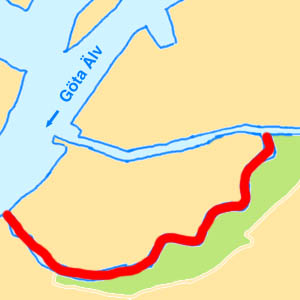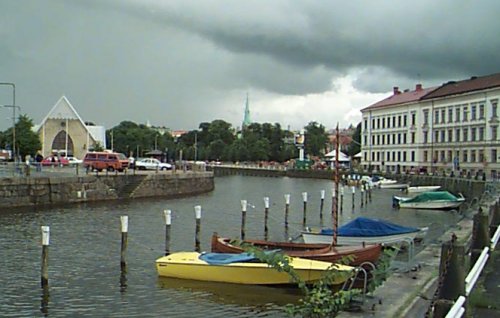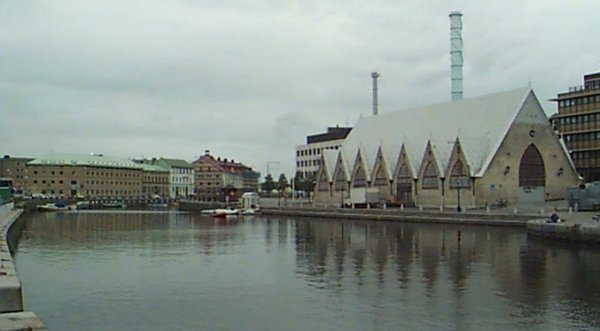
The Rosenlund Canal
Rosenlundskanalen
This a part of the moat and was thus a part of the defense-system. It is believed that the name comes from the many wild roses once growing beneath the Otterhälle hill.
This canal soon became the favourite among the fishmongers. All the fishermen from the archipelago came here with their catch and the place was called the Fish Square. There was a fish-raft in the canal and on this raft the people of Gothenburg could by their fresh fish. From the start this fish-raft had been in the Stora Hamnkanalen, but was moved to the Rosenlund canal when Gustav Adolfs Torg by the City Hall was made show up square in the 1850ies. And in 1874 the fishmongers got a suitable house when Feskekyrkan, the Fish-church, was built. This was a work by the wellknown architect Victor von Gegerfelt.
The people of Gothenburg found that this new house looked very much like a church, so it got it's name directly, and has kept ever since. Today Feskekyrkan is a popular visit both for the local people and for tourists.
The canal was also used as harbour for other things than fish. By the end of the 19th century great amounts of sand, bricks and wood were unloaded here and transported from here with horses and carriagies.
During many years a man called Kalle rowed a little ferry boat across the canal at Rosenlund. One penny for a ride. And this was well into the 1920ies. After that developement put an end to trade, ferries and canal traffic here. The swingbridges at Pustervik and by the iron scale was fixed and could no longer be opened from the 1950ies. Since then only low pleasure and sightseeingboats may pass. into the canal system via Rosenlund.
 The Rosenlund canal which the Feskekôrka and some pleasure boats. There are 89 mooring places for rent here.
The Rosenlund canal which the Feskekôrka and some pleasure boats. There are 89 mooring places for rent here.
Pustervik
Across the canal from Rosenlund is Pustervik, and this part if the canal is sometimes called the Pustervik canal. Here, and on the other side of the canal you can still see small pleasure boats moored. This is a last remnant of a formerly intense traffic with small boats in the canals.
In the Pustervik area the iron scale was located from 1785 to 1892. Previously it hade been located to Brunnsparken. Here the iron works in Värmland stored their iron while waiting for suitable ships for export. Iron stored here was sometimes pledged for money. The iron scale has lent it's name to the square near by, which is still called Järntorget - The Iron Square.
In early times Rustervik was a bay of the river and it got it's name from Germany where Putzieger Wiek means shallow bay of the sea. The nay was filled shen Rosenlundskanalen was built and definately during the 1880ies when Skeppsbro quaye was enlarged.
© Text written by Ingrid Wirsin
Ingrid Wirsin is a welknown journalist in Gothenburg, with a special feeling for buildings and history.
©Text 2001 by Ingrid Wirsin © Pictures Bosse Arnholm, 1999

Feskekôrka is a very popular market hall for fish of all kinds.
The name Feskekôrka is Swedish for "Fish-church" and as you can see on the picture it looks very much like a church too.
Do send comments or further information to: Bosse Arnholm!
 Click here to get back to the main Gothemburg-page.
Click here to get back to the main Gothemburg-page.
This page was last modified at
 The Rosenlund canal which the Feskekôrka and some pleasure boats. There are 89 mooring places for rent here.
The Rosenlund canal which the Feskekôrka and some pleasure boats. There are 89 mooring places for rent here.
 The Rosenlund canal which the Feskekôrka and some pleasure boats. There are 89 mooring places for rent here.
The Rosenlund canal which the Feskekôrka and some pleasure boats. There are 89 mooring places for rent here.
![]() Click here to get back to the main Gothemburg-page.
Click here to get back to the main Gothemburg-page.